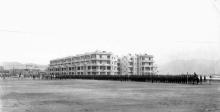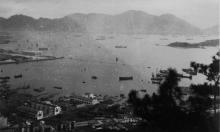Current condition
Demolished / No longer exists
Date completed
(Day & Month are approximate.)
Date closed / demolished
(Day & Month are approximate.)
Here is the approximate location of the Jubilee Buildings. They stood on the block bounded by Pratas Street, Hai Tan Street, Camp Street, and Tung Chau Street. When they were built, Tung Chau Street was the seafront, the southern edge of the Sham Shui Po reclamation.
They lay within the boundary of the Sham Shui Po army camp. Jason Wordie's 'Streets. Exploring Kowloon' mentions them:
A substantial block of flats on the waterfront, later known as Jubilee Buildings, was subsequently acquired by the military for use as married quarters. It had originally been built as a speculative venture by the prominent local Eurasian Hotung family.
Timeline:
- 1935 : Buildings completed - see comments below
- 1942-45: Part of the Shamshuipo Prisoner-of-war camp
- 19??: ???
- 1979-81: The Jubilee Transit Center (JTC), a transit center for Vietnamese refugees. Read more about the JTC at https://www.yha.org.hk/wp-content/uploads/2017/03/HMHH_Post-41_03.pdf (Thanks to Phil for the link)
- 1989: Aerial photos show the buildings have been demolished.



Comments
re: Jubilee Buildings
Message from 'wildwood081':
I lived in HK in the early 60's my dad being stationed there till about 1965 with the Royal Engineers. We lived in Jubilee Buildings and i would be intrested to hear from other 'army brats' who lived there also
re: Jubilee Buildings
You might find Howell Green's photos and descriptions of Sham Shui Po Camp interesting.
regards, David
Hmmmm, I was surprised to see
Hmmmm, I was surprised to see that Shamshuipo was actually on the harbor front at one point if I saw the picture correctly.
Jubilee Buildings 1946
Rich has uploaded these photos, with notes:
The photos were taken by my father about 1946. There is shell / bomb damage visible and a crane present. The door and window frames are absent due to looting by the locals who, apparently, were very short of firewood. My family would have moved in about mid 1947 when the building had been restored.
If you zoom in to the top photo you can see bomb damage above the left 'flagpole', and around the balcony on the far left.
Photos of Jubilee Blds
hi David
thank you for the photos of jubilee blds, though i lived there in the early 60's i can remeber the windows and how during the monsoon crabs and other local lizards would climb up the windows and into ur bedroom. really does bring back memories. I went to HK last year and could'nt find anything about jubilee Blds and it was disapointing
Many thanks for sharing
Paul
re: Photos of Jubilee Blds
Paul,
Glad to hear you enjoyed seeing the buildings again. Were you in the army at the time, or here as a child like the first commenter above?
Regards, David
Jubilee Buildings
I lived in Jubilee buildings from 1955 - 1959 when my father worked in civil service. I have many happy memories from that time, attendng St Georges school and going swimming on Stonecutters island.
re: Jubilee buildings from 1955 - 1959
You may also enjoy looking through our gallery of photos from the 1950s, and the notes & photos for Martin Booth's book.
We'd love to hear some of those happy memories, so please leave a comment on anything that catches your eye.
Regards, David
Pghotos of Jubilee Blds
hi David
No i was a kid of about 8-9 in the mid 60's but i remember quite a lot
Cheers paul
Minden Road school
After looking at the pics I remembered I also went to Minden Road School for a short time before starting at St Georges .Can't remember where it was located but I am meeting up soon with an old friend from HK days and will try and dig up some info. She has a better memory than me.
Regards, Evelyn
Minden Row
Apart from having a bad memory I obviously can't get names right either. Meant Minden Row School.
Cheers ,Evelyn
Re: Minden Row
Thanks Evelyn, fingers crossed you dig up some more information about the school.
Regards, David
No 95
Hi,
I lived there in the early 60's up till '65. My Dad was in the REME as well. We lived in no 95 on the third floor facing the soccer pitch. I have many fond memories of the place. I remember a kid called Christopher Taylor and another called Dean. I started school there. I don't remember the first school, but the second one was Gun Club junior school. I remember going on the 'Walla Walla' boats over to Stonecutters Island on a Sunday..
Jubilee Bldgs
I first became familiar with Jubilee Buildings in the mid to late 1970's. They were, by that period, in a dreadful state of affairs and nobody would have wanted to live in them at that time.
The bldgs were later used to house Vietnamese refugees (I believe) in the early 1980's. They also appear in the Canadian documentary "The Valour and the Horror - Captive Christmas."
Ghastly.
Tony Banham's book "We Shall Suffer There" describes in detail the actual location of the site.
Shamshuipo
It (Shamshiupo) was close to the waterfront, and into the 1970s [and probably right up to the date when British Forces left ahead of 1997] there was a jetty beyond Jubilee Buildings used by craft manned by Chinese (HKMSC) soldiers of the Maritime element of 31 Regiment RCT, HQ of which plus 29 Squadron (Lorries & other vehicles) of the regiment was in Shamshuipo Camp, along with several other Army Units, a large group of well-built permanent single-storey huts occupying the area between Laichikok Road & Cheungshawan Road.
Jubilee Transit Centre
The name of the Vietnamese refugee camp that used these buildings between 1979 and 1981 was the Jubilee Transit Centre.
The buildings are clear to
The buildings are clear to see in their seafront location on the 1952 map:
https://gwulo.com/jubilee-buildings?a=1#16/22.3305/114.1558/Map_by_ESRI…
Heritage of Mei Ho House
The people behind Post 41 at The Heritage of Mei Ho House produced an issue covering the use of the buildings as a refugee transit centre in the late 70s. It includes various personal stories, photos and location. You can view it online here: https://www.yha.org.hk/wp-content/uploads/2017/03/HMHH_Post-41_03.pdf&n…;
Date built?
Some good photos and stories in the document Phil links to above.
That got me wondering which year these were built. The 1935 PWD Annual Report has the entry:
27. Buildings of importance completed were:—
[...]
block of twenty-four European houses at Shamshuipo.
The photo shows two terraces back-to-back, and each terrace has 6 entrances. If we assume an entrance leads to two houses, that's 2 x 6 x 2 = 24. So it seems likely the report is referring to Jubilee Buildings, but has anyone seen any other proof?
Jubilee buildings Childrens party circa 1952
Have posted 3 photographs of a childrens party held outside Jubilee Buildings.
Date built?
That must be it IMHO. 1935 being the year of King George V's silver jubilee, and it's also unlikely at that time for there to be another large development of "European houses" in the area.
Thanks Bunce, I've set it to
Thanks Bunce, I've set it to 1935. If anyone finds any other evidence for or against that date, please leave a comment below.
Jubilee Buildings
I lived in Jubilee in 1968 and it was only a road's width from the sea, when there was a heavy sea it splahed on our ground floor flat windows and at the Southern end there was a ramp where LTSs used to Berth, I remember LST Lancelot and Bedivere being there at different times.
Jubilee Buildings
we had the misfortune to be allocated married quarters here back in 1968. What a dump, infested with cockroaches , right on the docks, bars on the window, (we were on the ground floor) not a good introduction to Army married accomodation. Fortunately we were soon moved to some lovely new quarters in Kowloon Tsai, we were in Durham Court, the railway ran alongside and we were right on the flightpath to Kai Tak but I loved it.
I lived in Jubilee Buildings in 1968
Jubilee Buildings
Sounds as though we must have beeen there about the same time, My husband was in the Lancashire fusiliers. Our son was also born at BMH in the August of '68
Hi Steve,
Hi Steve,
Do you happen to know Peter, Linda and Jenny Dunnet (Dunnett?) as well as William Sargent at Gun Club around 1960 - 62?
David
date of demolition
The date of demolition of the jubilee buildings should be 1990.
Jubilee buildings became a refugee camp in 1979 for vietnamese boat people.
The were newspaper articles reporting incidents inside the refugee camp like fightings etc up
til 1989. It is not correct to say the camp lasted only from 1979 to 1981.
=================================
The camp still existed on a map in 1987.
====================================
In 1989-5, there was a plan to rebuild the site.
=====================================
In a 1990-5 map, the jubilee buildings disappeared and the site labelled as "works in progress"
========================================================
Jubilee
"It is not correct to say the camp lasted only from 1979 to 1981"
These dates refer to its role purely as a transit centre i.e a holding place those people who had already been accepted by a foreign country. It may have remained a camp afterwards but this was not in the form of the "Jubilee Transit Centre" which had a more specific function.
The Govt aerial images show that the buildings had been demolished as early as August 1989, so i think 1989 can probably be entered as the demolition year.
date built 1928
block of twenty-four European houses at Shamshuipo built in 1935. It is not clear if they are the Jubilee buildings. Other sources seem to indicate the barracks and Jubilee buildings were completed in 1927.
https://www.master-insight.com/深水埗公園的前生事跡/
This is a 1928 picture showing the barracks and Jubilee buildings:
https://mmis.hkpl.gov.hk/coverpage/-/coverpage/view?_coverpage_WAR_mmis…
Re: Jubilee Buildings
Unaware of the connection to the Hotung family but in Barbara- Sue White's book "Turbans and Traders: Hong Kong Indian Communities" it mentions "The Jubilee Buildings in Sham Shui Po were commissioned by the Ruttonjees before World War II, leased to the British, then sold to the government after the war......"
Don't have access to the book or HKPL at the moment, so not able to track this one down.
two more pictures
1927
====================================
Sham shui po camps before the jubilee buildings appeared
============================================
1950s
Sham shui po camps with the jubilee buildings
======================================
Re: Jubilee Buildings
The reference to an "Indian speculator" and Sir Thomas Hotung (?) appear in Charles G. Roland's book "Long Night's Journey Into Day" here
So far no primary sources of information for the Jubilee Buildings prior to 1935. For now, looks like 1935 as the year of completion.